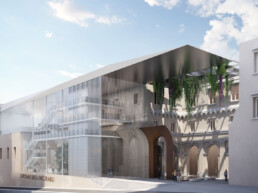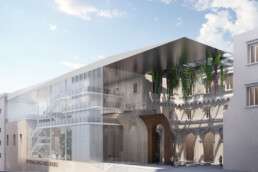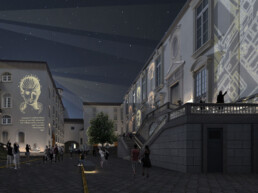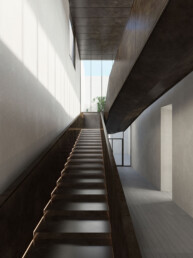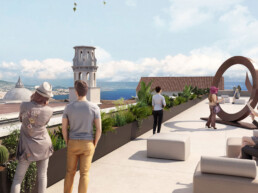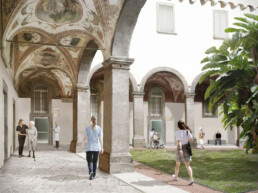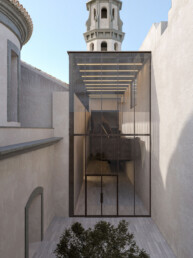Naples, Italy
Santa Maria del Popolo degli Incurabili
Year: 2021 – ongoing
Client: ASL Napoli 1 centro
Area: 20.829 sqm
Status: Ongoing
Design: RTI Studio Costa Architecture, Studio Associato di Architettura Carafa e Guadagno, Barretta & Partners, ia2 Studio Associato, General Engineering, Dodi Moss
CDO: A. Costa
Design Director: V. Didier
Project Leader: P. Mencacci
Team: V. D’Agostino, M. Rucci, S. Toldo
Visualizer: Opifex Laboratorio Digitale
Restauro: Fabrica Conservazione e Restauro s.c.p.l. – Dott.ssa Giorgia Galanti
Archeologia: Archeologo Dott. Nicola de Carlo
Naples, Italy
Santa Maria del Popolo degli Incurabili
Year: 2021 – ongoing
Client: ASL Napoli 1 centro
Area: 20.829 sqm
Status: Ongoing
Design: RTI Studio Costa Architecture, Studio Associato di Architettura Carafa e Guadagno, Barretta & Partners, ia2 Studio Associato, General Engineering, Dodi Moss
CDO: A. Costa
Design Director: V. Didier
Project Leader: P. Mencacci
Team: V. D’Agostino, M. Rucci, S. Toldo
Visualizer: Opifex Laboratorio Digitale
Restauro: Fabrica Conservazione e Restauro s.c.p.l. – Dott.ssa Giorgia Galanti
Archeologia: Archeologo Dott. Nicola de Carlo
The project for the requalification, restoration, and refunctionalization of the monumental complex of Santa Maria del Popolo degli Incurabili in Naples originates from the initiative of the General Director of the ASL Napoli 1, Engineer Ciro Verdoliva, with the aim of returning an immense historical heritage to the city of Naples and the entire community following the evacuation in April 2019 due to repeated structural failures and collapses of some parts of the building.
The former Incurables Hospital will be restored and partially converted into local healthcare services and partially into a museum. SCA has been responsible for the design of the museum area.
The strategy that guided the Project Concept starts with the consideration that the hospital complex was a place where many “knowledges” were preserved and cultivated. In our vision, this complex is set to regain its status as a healthcare institution and a cultural incubator. but instead of being a “sacred enclosure,” it will open up to the city, emphasizing its social function and once again becoming a place for reception, assistance, and the cultivation of knowledge. On an operational methodological level, we have defined four main areas of intervention: the interior spaces, the courtyards and gardens, the boundaries or “limes,” and the new areas.
For each of these areas, a different approach has been outlined:
Interior Spaces: For the restoration of the interior spaces, we have designed an intervention aimed at restoring the valuable elements to their former splendor and completely modernizing the areas that will become a model healthcare facility or museum.
Open Spaces: The project’s interventions focus on significant restoration to redefine the historic splendor in its entirety, aligning with the framework of the 1981 Carta dei Giardini Storici di Firenze. We have chosen to give a public character to the open spaces, while maintaining their private rights, in order to open the complex and make it permeable to the city.
Boundaries: A different theme is reserved for the “edges” of the complex, emphasizing the relationship with the external world, the city, and the neighborhood in which this historic complex was born and is rooted. In this case, we propose an intervention that aims to “facilitate the interpretation of the historical-artistic and testimonial architectural elements that compose the complex,” leaving the stratifications intact and removing only the superimpositions.
New: The new additions are in continuity with the history of the building complex, expressed in a clear and contemporary language, as seen in the numerous layers within the complex. Within these areas, the design themes of the Museum/Cultural Center and the Hospital are developed. For the museum, the design focuses on the monumental courtyard, where various functions are intertwined: exhibition spaces, the Historical Pharmacy, the Alchemy Museum, the Library/Digital Innovation Hub, the Tea Room, and the Bookshop. The former Healthcare Management building will be converted on the ground floor into Conservation and Restoration Laboratories, while the upper floors will accommodate educational laboratories related to museum visits, offices, and exhibition spaces on the last two levels. The top floor of the museum area hosts temporary exhibitions and a restaurant with an open-air terrace.
For the hospital, which will accommodate residential, semi-residential, and outpatient activities, as well as various healthcare and non-healthcare support services, the project focuses on the new entrance from Salita Maria Longo. Here, the secondary cloister of Santa Maria delle Grazie and the “Diruto” area serve as entrance and vertical and horizontal connections for the hospital. The starting point for the design lines was to address construction and structural issues and, most importantly, to clarify the functional areas of the complex, redefine museum and hospital routes, and create spaces for temporary events and the exchange of knowledge.
